

Nickanan Night. Nickanan Night (sometimes called Hall Monday or Peasen Monday) is a Cornish feast, traditionally held on the Monday before Lent.[1] Sometimes called roguery night in West Cornwall, England, UK, this event was an excuse for local youths to undertake acts of minor vandalism and play practical jokes on neighbours and family.[2] The name Nickanan may come from the practice of knocking on doors and running away which is known as 'Nicky nicky nine doors' in some parts of English speaking world.
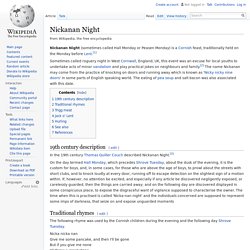
The eating of pea soup and salt bacon was also associated with this date. 19th century description[edit] In the 19th century Thomas Quiller Couch described Nickanan Night.[3] Easter. Help support New Advent and get the full contents of this website as an instant download.

Includes the Catholic Encyclopedia, Church Fathers, Summa, Bible and more — all for only $19.99... The English term, according to the Ven. Bede (De temporum ratione, I, v), relates to Estre, a Teutonic goddess of the rising light of day and spring, which deity, however, is otherwise unknown, even in the Edda (Simrock, Mythol., 362); Anglo-Saxon, eâster, eâstron; Old High German, ôstra, ôstrara, ôstrarûn; German, Ostern. April was called easter-monadh.
The plural eâstron is used, because the feast lasts seven days. What is the origin of Easter? Also read: Is “Easter” mentioned in Scripture?

Answer The name “Easter” has its roots in ancient polytheistic religions (paganism). On this, all scholars agree. Ancient Human Metropolis Found in Africa is 200,000 years old! "I see myself as a fairly open-minded chap but I will admit that it took me well over a year for the penny to drop, and for me to realise that we are actually dealing with the oldest structures ever built by humans on Earth.
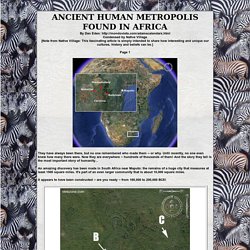
The main reason for this is that we have been taught that nothing of significance has ever come from southern Africa. That the powerful civilizations all emerged in Sumeria and Egypt and other places. We are told that until the settlement of the BANTU people from the north, which was supposed to have started sometime in the 12th century AD, this part of the world was filled by hunter gatherers and so-called Bushmen, who did not make any major contributions in technology or civilization.
" -- Tellinger A Rich and Diverse History When explorers found these ruins, they thought they were 13th-century cattle corals made by nomadic tribes who settled the land. First evidence of farming in Mideast 23,000 years ago: Evidence of earliest small-scale agricultural cultivation. Until now, researchers believed farming was "invented" some 12,000 years ago in the Cradle of Civilization -- Iraq, the Levant, parts of Turkey and Iran -- an area that was home to some of the earliest known human civilizations.
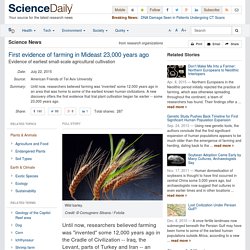
A new discovery by an international collaboration of researchers from Tel Aviv University, Harvard University, Bar-Ilan University, and the University of Haifa offers the first evidence that trial plant cultivation began far earlier -- some 23,000 years ago. The study focuses on the discovery of the first weed species at the site of a sedentary human camp on the shore of the Sea of Galilee. It was published in PLOS ONE and led by Prof. Les grottes préhistoriques ornées. Life Expectancy. Richard Field on Management and Information Science Home > Archive > Life Expectancy The generalization is often stated that life expectancy in earlier times was short.

ANCIENT EGYPT : Introducing Ancient Egyptian Religion, Ritual and Philosophy. Timelines of Asia TOC: India, China, Japan. Oxyrhynchus. Location of Oxyrhynchus in Egypt Etymology[edit]
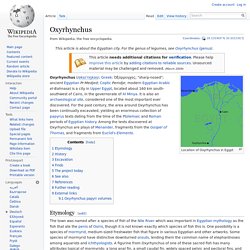
Once Upon A Time. Long Time Gone. Long Ago. Mythos. GNOSIS OF MYTH: Noah’s Ark. Introduction There are numerous debates surrounding the story of Noah’s Ark.
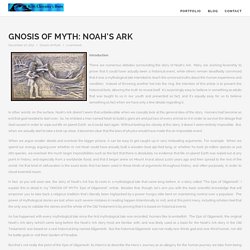
Many are working feverishly to prove that it could have actually been a historical event, while others remain steadfastly convinced that it was a mythological tale intended to teach the universal truths about the human experience and condition. Instead of throwing another hat into the ring, the intention of this article is to present the historical facts, allowing the truth to reveal itself.
It’s surprisingly easy to believe in something as adults that was taught to us in our youth and presented as fact, and it’s equally easy for us to believe something as fact when we have only a few details regarding it. Ancestral Lines. Evolutionary biologists use a cladogram, the treelike diagram of evolutionary branches or clades, to organize species into lines of evolutionary descent across time.
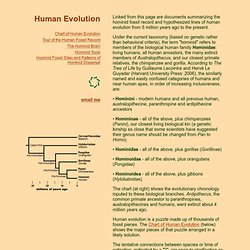
Biologists use three types of evidence to deduce evolutionary connections: genetics, morphology, and geologic dating. (Behavior, normally a key part of evolutionary studies, can only be inferred in extinct species — for example, by examining the ecology in which the species flourished and the species adaptations for eating and locomotion.) Analyses of primate fossils and the genetic relatedness of living primates converge to the conclusion that humans and chimpanzees branched from a common ancestor about 7 million years ago. DNA recovered from several uncontaminated Neanderthalensis fossils indicated that modern humans and extinct neanderthals diverged about 400,000 years ago; but more recent studies show that they must have interbred within Europe or the Middle East since then.
List of cartographers. Cartography is the study of map making and cartographers are map makers.
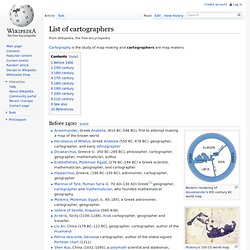
Before 1400[edit] Modern rendering of Anaximander's 6th century BC world map. Anthropology. Histomap of Evolution - Scaled (28%) Festivals, Food and Farming. My original reasons for taking up the study of Proto-Indo-European religion had nothing to do with religion. I just had a few tiny questions related to gardening, such as what time of year to plant spelt, and which Goddess would be suitable as a garden ornament, since I was thinking of getting a statue to use as a focal point. And finally, I wondered why I didn’t know a single traditional harvest song, because I always feel like singing in the garden. To my amazement, I was unable to find out this basic information. Local garden centers did not have any advice on when to plant spelt, a traditional grain that people don’t normally grow in their gardens. Adipocere Main: FOOD OF THE PIONEERS. 9,000 B.C. - 3,000 B.C.
World-Mysteries.com. Oldest Civilisation. Oldest Civilization Click on underlined words to open paragraph Indus Script- the mother of all alphabetic scripts Click below to read the report and see the NASA image NASA Images Discover Ancient Bridge Between India & Sri Lanka The bridge's unique curvature and composition by age reveals that it is man made. Fossil Hominids: the evidence for human evolution. Frontiers of Anthropology. Australopithecus Sediba & Human Evolution. Faces of Our Ancestors. Our forgotten brothers. Mediteraneo เมดิเตอร์เรเนียน 地中海 先民, Grekujo 希腊 กรีซ, Hispanujo สเปน 西班牙, Italujo arbaro 意大利 刚果的森林 คองโก ป่า อิตาลี Xitālī, Sardinio 撒丁岛 ซาร์ดิเนีย Sār̒dineīy, Lazio: ลาซิโอ, lā si xo, Romo โรม 罗马, Tibero rivero แม่น้ำ อิตาลี Mæ̀n̂ả Xitālī Camunni.
The history of Valle Camonica (near city of Brescia) begins with the end of last ice age, 15,000 years ago when the glacier, melting, creates the valley. Pictograph Photos. The Archaeology News Network: Skulls with mix of Neanderthal and primitive traits illuminate human evolution. Researchers studying a collection of skulls in a Spanish cave identified both Neanderthal-derived features and features associated with more primitive humans in these bones.
This "mosaic pattern" supports a theory of Neanderthal evolution that suggests Neanderthals developed their defining features separately, and at different times – not all at once. Having this new data from the Sima de los Huesos site, as the Spanish cave is called, has allowed scientists to better understand hominin evolution during the Middle Pleistocene, a period in which the path of hominin evolution has been controversial. Mesopotamian Astronomy - Babylonian and Persian History. Skulls from Spanish cave illuminate human evolution. Article created on Friday, July 11, 2014 Researchers studying a collection of skulls in a Spanish cave identified both Neanderthal-derived features and features associated with more primitive humans in these bones. This “mosaic pattern” supports a theory of Neanderthal evolution that suggests Neanderthals developed their defining features separately, and at different times – not all at once.
Unbelievable Skeletons Unearthed From The Catacombs Of Rome. The First Americans. World History. History. Historic People. Ancient Civilizations. Ancient Civilizations. Historical Handfasting. Saved by fire: breads in archeology. Of all artifacts in archeology, bread might be the least likely to survive. It is made after all to be consumed, to disintegrate in liquids, to crumble. And yet... it does. Rarely, relative to other products, and still more rarely as a coherent object. In ancient Egypt, summer was the season for making babies. Names of the Levant. Cities of the ancient Near East.
The largest cities in the Bronze Age ancient Near East housed several tens of thousands. Plovdiv. Myths & Facts: A Guide to the Arab-Israeli Conflict. Ancient Scripts: Home. Myth of Invasion Rig veda Aryans. Ancient Roman History Timeline. Egyptmysteries.org. Runes. PROTO-INDO-EUROPEANS 12 pp pdf.